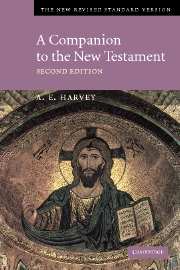Book contents
- Frontmatter
- Contents
- Preface
- Preface to the First Edition (1970)
- THE NEW TESTAMENT
- THE GOSPELS
- THE ACTS OF THE APOSTLES
- LETTERS
- Romans
- 1 Corinthians
- 2 Corinthians
- Galatians
- Ephesians
- Philippians
- Colossians
- 1 Thessalonians
- 2 Thessalonians
- 1 Timothy
- 2 Timothy
- Titus
- Philemon
- Hebrews
- James
- 1 Peter
- 2 Peter
- 1 John
- 2 John
- 3 John
- Jude
- THE REVELATION
- Old Testament References
- Index
- Frontmatter
- Contents
- Preface
- Preface to the First Edition (1970)
- THE NEW TESTAMENT
- THE GOSPELS
- THE ACTS OF THE APOSTLES
- LETTERS
- Romans
- 1 Corinthians
- 2 Corinthians
- Galatians
- Ephesians
- Philippians
- Colossians
- 1 Thessalonians
- 2 Thessalonians
- 1 Timothy
- 2 Timothy
- Titus
- Philemon
- Hebrews
- James
- 1 Peter
- 2 Peter
- 1 John
- 2 John
- 3 John
- Jude
- THE REVELATION
- Old Testament References
- Index
Summary
Both parts of this title raise questions. Is this really a ‘letter’? And who was ‘John’?
The first question arises from the opening, “We declare to you what was from the beginning”. This is not how one would expect any letter, ancient or modern, to begin; nor is there any greeting at the end to make up for the lack of one at the beginning (as there is in Hebrews, the only other New Testament ‘letter’ which begins so abruptly). The document is certainly not a ‘letter’ in the ordinary sense. Neither, apparently, is it a letter in the literary sense (which was widely accepted in the ancient world) of a piece of religious or philosophical writing dressed up in the form of a letter; for such ‘letters’ always had at least the conventional greetings at the beginning and the end. The writer starts straight in on his subject, and at first sight he appears to be writing a treatise or a sermon. Yet a few lines further down he begins a new paragraph with the words, “My little children, I am writing these things to you.” There is nothing conventional or literary about this: we are reading a real message written to a real congregation. A pastor is appealing to his flock; and for some reason unknown to us he does not make his appeal in person but writes it down and sends it to them.
- Type
- Chapter
- Information
- A Companion to the New Testament , pp. 757 - 772Publisher: Cambridge University PressPrint publication year: 2004



